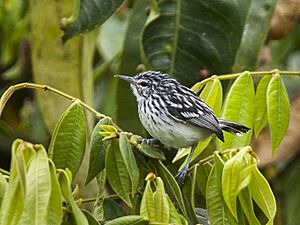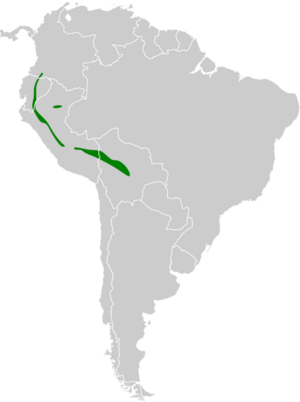Stripe-chested antwren facts for kids
Quick facts for kids Stripe-chested antwren |
|
|---|---|
 |
|
| Conservation status | |
| Scientific classification | |
| Genus: |
Myrmotherula
|
| Species: |
longicauda
|
 |
|
The stripe-chested antwren (Myrmotherula longicauda) is a small bird. It belongs to the "typical antbirds" family, called Thamnophilidae. You can find this bird in several South American countries. These include Bolivia, Colombia, Ecuador, and Peru. It is known for its distinct striped chest.
Contents
About the Stripe-Chested Antwren
The stripe-chested antwren is a small bird. It measures about 9 to 11 centimeters (3.5 to 4.3 inches) long. It weighs between 8 and 9.5 grams (0.28 to 0.34 ounces). This bird has a slightly longer tail compared to other birds in its group.
What Does It Look Like?
Adult male stripe-chested antwrens have a face and neck with black and white stripes. Their head, back, and rump are black. These parts also have white or light gray stripes. Their tail is black with white edges and tips on the feathers.
Their wings are black. They have wide white edges on the main wing feathers and narrower white edges on the flight feathers. The throat, chest, and belly are white. The chest and sides have light black stripes.
Adult females look a bit different. They have buff-colored stripes instead of white ones on their face, head, and upper body. Their wing feathers have white or buff edges. Their underparts are buff, but lighter on the throat and belly. The sides of their chest have a small amount of light gray streaking.
Both males and females have dark brown eyes. Their upper beak can be black, dark gray, or bluish gray. Their lower beak is gray to bluish gray. Their legs and feet are also gray to bluish gray. The differences in feathers among the different types of this bird are very small.
Where the Stripe-Chested Antwren Lives
The stripe-chested antwren lives in separate areas along the eastern side of the Andes mountains.
Different Types and Their Homes
There are four main types, or subspecies, of the stripe-chested antwren:
- M. l. soderstromi: Found in southern Colombia and northern Ecuador.
- M. l. pseudoaustralis: Lives from southern Ecuador down into Peru. There is also a separate group in Peru's Loreto region.
- M. l. longicauda: Found in Peru's Junín region.
- M. l. australis: Lives from southern Peru down into northwestern Bolivia.
Habitat and Elevation
In most places, the stripe-chested antwren lives at the edges of wet evergreen forests. It also lives in younger forests that have grown back, and in bamboo patches. These birds usually live at elevations between 400 and 1550 meters (1,300 to 5,100 feet).
However, in Colombia, they are found only up to 1100 meters (3,600 feet). In Ecuador, they mostly stay below 1000 meters (3,300 feet). The group in Loreto, Peru, lives in forests that are always flooded. These forests are around blackwater lakes at about 150 meters (490 feet) elevation.
Stripe-Chested Antwren Behavior
Movement and Travel
Scientists believe the stripe-chested antwren stays in the same area all year. It does not migrate to different places.
What Do They Eat?
We don't know a lot about what the stripe-chested antwren eats in detail. However, we do know it eats insects and spiders. These birds usually look for food alone or in pairs. They rarely join large groups of different bird species that are feeding together.
They mostly search for food in thick leaves and tangled vines. They also look along branches. They find their prey by reaching, lunging, or making short flights from a perch. They usually feed in the middle parts of the forest, about 2 to 8 meters (7 to 26 feet) above the ground. Sometimes, they go almost to the ground or as high as 15 meters (49 feet).
Reproduction and Life Cycle
Not much is known about how the stripe-chested antwren reproduces or raises its young.
Sounds and Calls
The stripe-chested antwren has a special song. It is described as a fast, musical sound like "chidu-chidu-chidu-chidu..." with many notes. Its call is a double note followed by a short trill, like "chiwi-chrrrrrrt." Other people describe its song as a slow, steady series of musical pairs: tee-tip tee-tip tee-tip tee-tip tee-tip. Its calls can also be a descending tew, quiet sick-sick notes, and a ringing, harsh rattle.
Conservation Status
The IUCN (International Union for Conservation of Nature) says the stripe-chested antwren is a species of "Least Concern." This means it is not currently in danger of disappearing. It lives across a fairly large area.
However, its population size is not known, and it is thought to be decreasing. There are no immediate threats that have been found. The bird is quite common in Peru and "locally not uncommon" in Ecuador. But in Colombia, it is considered "local and rare."
Even though the stripe-chested antwren lives in places like forest edges, which can be created by natural events, it is still at risk. This is because people often clear forests for farming in the lower parts of the Andes mountains, where this bird lives. This loss of habitat can harm the bird's population.


